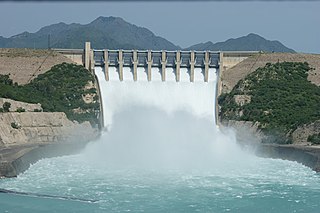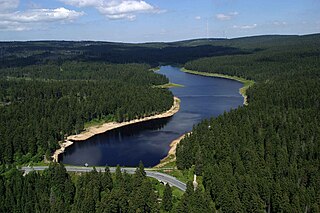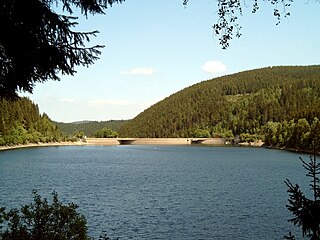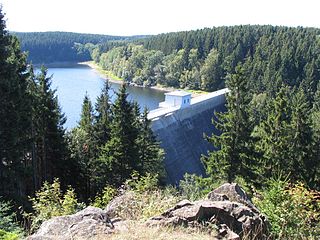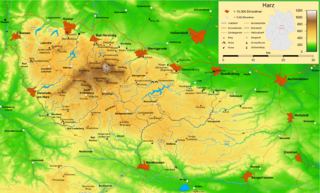| Söse Dam | |
|---|---|
| Country | Germany |
| Location | Lower Saxony |
| Coordinates | 51°44′21″N10°19′34″E / 51.73917°N 10.32611°E Coordinates: 51°44′21″N10°19′34″E / 51.73917°N 10.32611°E |
| Construction began | 1928 (Harzwasserwerke) |
| Opening date | 1931 |
| Dam and spillways | |
| Type of dam | Embankment dam |
| Height | 56 m (184 ft) |
| Length | 485 m (1,591 ft) |
| Width (crest) | 9 m (30 ft) |
| Dam volume | 1,900,000 m3 (67,000,000 cu ft) |
| Reservoir | |
| Total capacity | 26,250,000 m3 (927,000,000 cu ft) |
| Catchment area | 49 km2 (19 sq mi) |
| Surface area | 124 ha (0 sq mi) |
| Power Station | |
| Installed capacity | 1.44 MW |
The Söse Dam is a dam in the Lower Saxon part of the Harz mountains near Osterode in the German state of Lower Saxony.

A dam is a barrier that stops or restricts the flow of water or underground streams. Reservoirs created by dams not only suppress floods but also provide water for activities such as irrigation, human consumption, industrial use, aquaculture, and navigability. Hydropower is often used in conjunction with dams to generate electricity. A dam can also be used to collect water or for storage of water which can be evenly distributed between locations. Dams generally serve the primary purpose of retaining water, while other structures such as floodgates or levees are used to manage or prevent water flow into specific land regions. The earliest known dam is the Jawa Dam in Jordan, dating to 3,000 BC.

Osterode am Harz often simply called Osterode, is a town in south-eastern Niedersachsen on the south-western edge of the Harz mountains. It was the seat of government of the district of Osterode. Osterode is located on the German Timber-Frame Road.

Lower Saxony is a German state (Land) situated in northwestern Germany. It is the second-largest state by land area, with 47,624 km2 (18,388 sq mi), and fourth-largest in population among the 16 Länder federated as the Federal Republic of Germany. In rural areas, Northern Low Saxon and Saterland Frisian are still spoken, but the number of speakers is declining.
Contents
It was the first modern dam and reservoir complex (German: Talsperre) to be built in the Harz [1] and was constructed by the Harzwasserwerke between 1928 and 1931. It is used for flood prevention, electricity generation, supplying drinking water and for raising water levels during times of low water. The construction of the dam cost 14.7 million Reichsmarks at the time. The Harzwasserwerke still operate the dam today. In 1933 construction began on a long-distance water pipe from the Söse reservoir, whose northern branch goes as far as Bremen. Today it mainly supplies towns and communities in the Hildesheim and Hanover areas. Since 1980 the town of Göttingen has also been supplied with drinking water from the reservoir.
The Harzwasserwerke GmbH is a major German water company and dam operator based in Hildesheim, located within the German federal state of Lower Saxony.

Electricity generation is the process of generating electric power from sources of primary energy. For electric utilities in the electric power industry, it is the first stage in the delivery of electricity to end users, the other stages being transmission, distribution, energy storage and recovery, using the pumped-storage method.

Drinking water, also known as potable water, is water that is safe to drink or to use for food preparation. The amount of drinking water required varies. It depends on physical activity, age, health issues, and environmental conditions. Americans, on average, drink one litre of water a day and 95% drink less than three litres per day. For those who work in a hot climate, up to 16 litres a day may be required. Water is essential for life.








